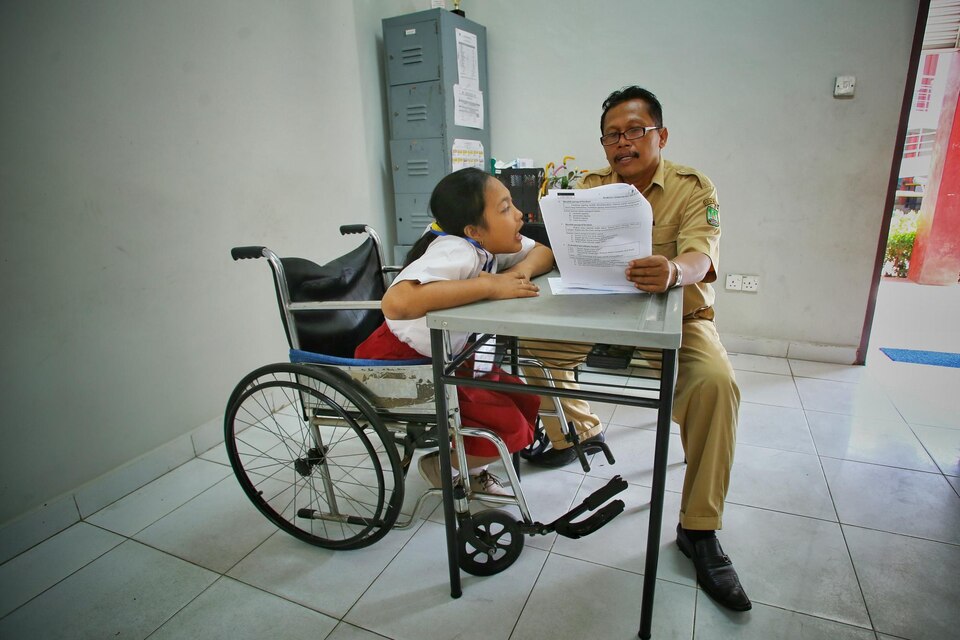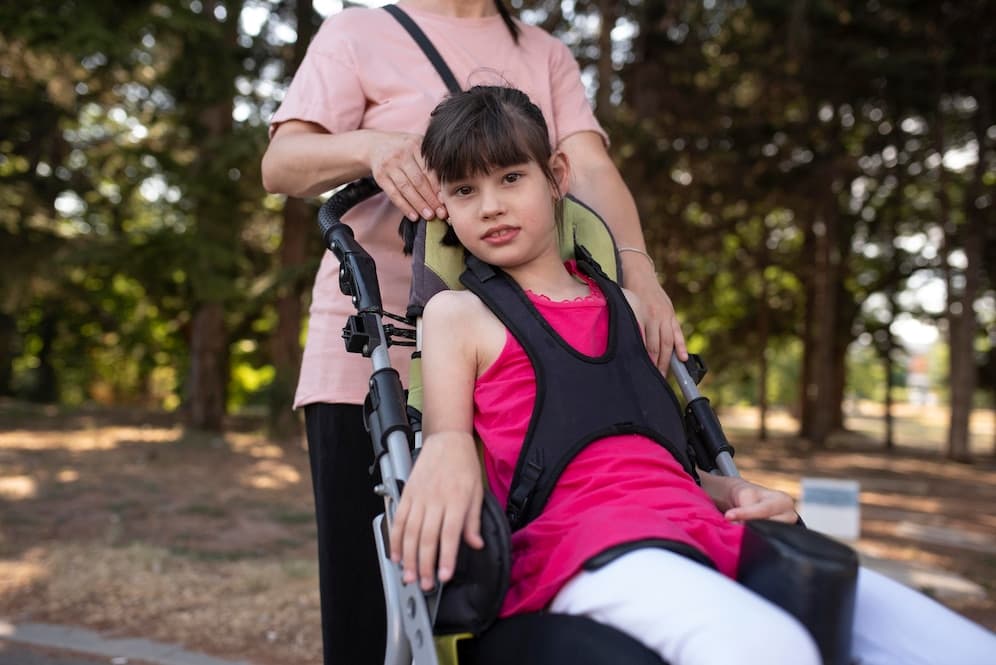Last updated on May 10th, 2025 at 06:12 pm
 Understanding cerebral palsy
Understanding cerebral palsy
Cerebral palsy (CP) is a neurological disorder affecting movement, posture, and muscle coordination. It is caused by abnormal development or damage to the brain that occurs before, during, or shortly after birth.
Symptoms vary from person to person but may include muscle stiffness or spasticity (abnormal increase in muscle tone or stiffness of muscle), balance and coordination problems, speaking, eating, and learning difficulties. Cerebral Palsy is a lifelong condition, but treatment can help improve movement and lessen symptoms.
CP is one of the most common childhood motor disabilities, affecting approximately two to three out of every 1,000 births in India. While there is no cure for the disorder, there are treatments that can help improve functioning and quality of life. Cerebral palsy is also a chronic ailment in children, where the symptoms and severity vary from person to person.
Understand the Basics of Generic Medicines | Branded Medicines vs Generic Medicines
Common symptoms of cerebral palsy
Common symptoms of cerebral palsy can vary from person to person, depending on the severity of the condition.
However, some of the more common symptoms of cerebral palsy include:
1. Muscle spasticity:
This is the most common symptom of cerebral palsy and is characterized by tight, stiff muscles that limit movement. This can cause jerky, awkward movements and can interfere with normal activities.
2. Uncontrolled movements:
People with cerebral palsy may also experience uncontrolled movements, such as tremors, writhing, and shaking. These involuntary movements can be frequent and unpredictable.
3. Poor coordination:
Cerebral palsy may lead to difficulty coordinating voluntary movements, such as walking or buttoning a shirt. They may also have trouble with activities that require fine motor skills, such as writing or cutting with scissors.
4. Difficulty with posture and balance:
People with cerebral palsy may have trouble maintaining their balance and posture, leading to frequent falls. They may also have trouble sitting up, standing, or walking.
5. Speech difficulties:
People with cerebral palsy may struggle with language or speaking. They may have trouble forming words, or their speech may be slurred or hard to understand.
6. Difficulty with swallowing:
Those with cerebral palsy may also experience difficulty swallowing, called dysphagia. This can lead to choking, coughing, or drooling when eating.
7. Intellectual disabilities:
Intellectual disabilities can range from mild to severe and affect a person’s ability to think, reason, and solve a problems.
8. Vision, hearing, and dental problems:
People with cerebral palsy may also have vision, hearing, and dental problems. They may have difficulty seeing, hearing, or speaking clearly, and may have poor oral hygiene due to difficulty brushing and flossing their teeth.
9. Seizures:
Seizures are a common symptom of cerebral palsy, ranging from mild to severe. Seizures can cause loss of consciousness, shaking, and changes in behavior. While the severity of cerebral palsy symptoms can vary from person to person, all people with the condition will experience some degree of physical, mental, and cognitive disability.
Causes of Cerebral Palsy
The cause of cerebral palsy is often unknown, but it can be caused by various factors before, during, and shortly after birth.
These include;
1. Preterm birth:
Babies born before 37 weeks are at risk for developing CP due to immature brain development.
2. Lack of oxygen during birth:
If the baby does not receive enough oxygen during birth, it can lead to brain damage, resulting in cerebral palsy.
3. Complications during delivery:
A prolapsed (displaced from its normal position) umbilical cord can prevent oxygen from reaching the baby’s brain and cause CP.
4. Infections during pregnancy:
Certain infections, such as rubella, can cause brain damage in a developing fetus, resulting in CP.
5. Head injuries:
Traumatic head injuries due to accidents or abuse can also cause CP. Diagnosis Cerebral palsy is usually diagnosed in infancy or early childhood.
If your child has any of the symptoms listed above, you should talk to your pediatrician immediately.
Diagnosis for cerebral palsy
The first step in diagnosing cerebral palsy is to look at the infant or child’s history and physical development. The doctor will look for any signs that may indicate the presence of cerebral palsy. This includes slow or uneven physical development, delays in learning to sit up, crawl, or walk, and issues with balance or coordination.
If there are any signs of cerebral palsy, the doctor may order additional tests to confirm the diagnosis. The most common test used to diagnose cerebral palsy is an MRI scan that can detect areas of the brain that have been damaged or not developed properly.
Other tests that may be used to diagnose cerebral palsy include an electroencephalogram (EEG) to detect abnormal electrical activity in the brain, a CT scan to look for abnormalities in the brain’s structure, and a muscle biopsy to look for any abnormalities in the muscle tissue.
Once the tests have been administered and the results obtained, the doctor will make a diagnosis based on the results. If the results are inconclusive, the doctor may recommend additional tests or refer the patient to a specialist for a more comprehensive evaluation. In some cases, a diagnosis of cerebral palsy may only be made once the child is older.
If the child is not displaying any signs of cerebral palsy but has a family history of the disorder, the doctor may recommend genetic testing. This test can determine if the child is at risk of developing the disorder. It is important to remember that a diagnosis of cerebral palsy may only be made once the child reaches adulthood.
 Treatment of cerebral palsy
Treatment of cerebral palsy
There is no cure for cerebral palsy, but there are treatments available that can help improve functioning and quality of life. Physical therapy helps to strengthen muscles and improve balance and coordination.
Occupational therapy helps with daily tasks such as dressing and eating. Speech therapy helps with communication and swallowing difficulties. Medications can help reduce muscle stiffness and spasms as well as reduce pain.
Doctors may recommend surgery if the patient has severe spasticity or deformities affecting their daily functioning. Supporting devices such as wheelchairs and walkers can also help improve mobility.
It is important to note that every individual with cerebral palsy is different and will respond differently to treatments. Talking with your doctor about what treatments may be right for you or your loved one is important.
Generic medicines for Cerebral Palsy
Generic medicines have been a game-changer in treating Cerebral Palsy (CP), a condition affecting over 17 million people worldwide. CP is caused by a disruption in the brain’s ability to control movement, often resulting in physical impairments like difficulty walking, speaking, and other activities. The condition can be managed through medications, which have traditionally been expensive and inaccessible to many people. Generic medicines, however, have become a viable option for individuals who cannot afford traditional medications.
Generic drugs are copies of brand-name drugs produced by different companies and sold at a fraction of the cost. They all meet WHO-GMP standards, ensuring safety, effectiveness, and reliability as their brand-name counterparts. Generic drugs have been used to treat CP for decades, but their role has become increasingly important in recent years.
Generic drugs can reduce the cost of treating CP, as many patients and their families are already struggling to afford the high cost of traditional treatments. Generic drugs can also treat many of the secondary symptoms associated with CP.
For instance, they can control muscle spasms, reduce pain, and improve coordination and balance. In addition, they can help to reduce the risk of seizures, which can be a major problem for people with CP.
Medkart is one of the leading generic pharmaceutical sellers in India with over 100+ stores. You can also order generic medicine online at medkart.in or use our iOS and android applications.
